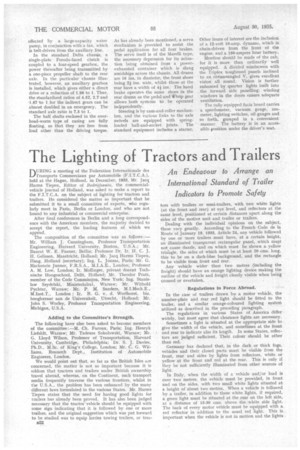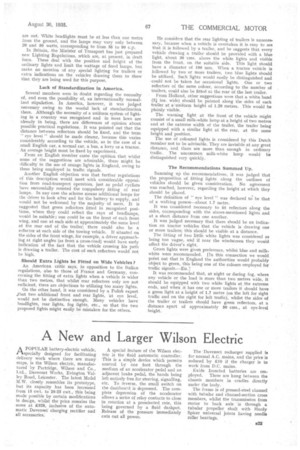The Lighting of Tractors and Trailers
Page 28

Page 29

If you've noticed an error in this article please click here to report it so we can fix it.
DURING a meeting of the Federation Internationale des 1./Transports Commerciaux par Automobile (F.I.T.C.A.), held at the Hague, Holland, in December, 1933, Mr. Jacq Harms Tiepen, Editor of Bedrijfsauto, the commercialvehicle journal of Holland, was asked to make a report to the F.I.T.C.A. on the subject of lighting for tractors and trailers. He considered the matter so important that he submitted it to a small committee of experts, who regularly meet in Paris, Berlin or London, and who are not bound to any industrial or commercial enterprise.
After final conferences in Berlin and a long correspondence with the American members, the majority decided to accept the report, the leading features of which we append.
The composition of the committee was as follows Mr. William J. Cunningham, Professor Transportation Engineering, Harvard University, Boston, TJ.S.A.; Mr. Baurat W. E. Fauner,lin; Professor Dr. Ir. H. C. J. H. Gelissen, Maastricht, Holland; Mr. Jacq Harms Tiepen, Haag, Holland (secretary); Ing. L. Jonasz, Paris; Mr. G. Mackenzie Junner, F.R.S.A.. M.I.A.E., London; Professor A. M. Low, London; Ir. Mollinger, privaat docent Technische Hoogeschool, Delft, Holland; Mr. Theodor Pratt, member of the Code Commission, New York; Ing. Stanislaw Szydelski, Ministerialrat, Warsaw; Mr. Withold Pychter, Warsaw; Mr. P. M. Sanders, M.I.Mech.E., M.Inst.T., London ; Ir. B. G. v. d. Werffiorst, biz. hoogleeraar aan de Universiteit, Utrecht, Holland; Mr. John S. Worley, Professor Transportation Engineering, Michigan, U.S.A.
Adding to the Committee's Strength.
The following have also been asked to become members of the committee :—M. Ch. Faroux, Paris; Ing. Henryk Liefeldt, Warsaw; Mr. Tadeusz Sokolowski, Warsaw; Mr. G. Lloyd Wilson, Professor of Transportation, Harvard University, Cambridge, Philadelphia; Dr. S. J. Davies, Ph.D., M.Sc. of King's College, London; Mr. C. G. Williams, Research Dept., Institution of Automobile Engineers, London.
We would point out that, so far as the British Isles see concerned, the matter is not so important because it is seldom that tractors and trailers under British ownership travel abroad, whereas, on the Continent, such transport media frequently traverse the various frontiers, whilst in the U.S.A., the problem has been enhanced by the many different laws formulated in the various States. Mr. Harms Tiepen states that the need for having good lights for trailers has already been proved. It has also been judged necessary that the tractor-vehicle should be equipped with some sign indicating that it is followed by one or more trailers, and the original suggestion which was put forward to be studied was to equip lorries towing trailers, or trac
B22
tors with trailers _or semi-trailers, with two white lights (at the front and rear) at eye level, and reflectors at the same level, positioned at certain distances apart along the sides of the motive unit and trailer or trailers.
Dealing with the individual opinions on the subject, these vary greatly. According to the French Code de la Route of January 19, 1933, Article 24, any vehicle followed by one or more trailers must have, at a certain height, an illuminated transparent rectangular panel, which must not cause dazzle, and on which must be shown a yellow tria'ngle, the sides of which must be at least 20 cms, long, this to be on_ a dark-blue background, and the rectangle to be visible from front and rear.
Any vehicle wider than two metres (including the freight) should have an orange lighting device making the outline of the vehicle and freight clearly visible when being crossed or overtaken.
Regulations in Force Abroad.
In the case of trailers drawn bya motor vehicle, the number-plate and rear red light should be fitted to the trailer, and a similar orange-coloured lighting systeni utilized as described in the preceding paragraph. '• The regulations in various States of America differ widely, but most agree that clearance lights are necessary.
Sometimes a light is situated at the appropriate side to give the width of the vehicle, and sometimes at the front and rear to indicate also its length. In some States, reflectors are judged sufficient. Their colour should be other than red.
Germany has declared that, in the dark or thick fogs, vehicles and their closed parts must be visible from the front, rear and sides by lights from reflectors, white or yellow at the front and red at the rear. This is only if they be not sufficiently illuminated from other sources of light.
In Italy, when the width of a •vehicle and/or load is over two metres, the vehicle must be provided, in front and on the sides, with two small white lights situated at a height of about two metres. When a vehicle is followed by a trailer, in addition to these white lights, if required, a green light must be situated at the rear on the left side, at a distance of 15-30 cms. above the white side light. The back of every motor vehicle must be equipped with a red reflector in addition to the usual red light. This is important when the vehicle is not in motion and the lights
are out. White headlights must be at less than one metre from the ground, and the lamps may vary only between 20 and 50 watts, corresponding to from 35 to 90 c.p, In Britain, the Minister of Transport has just prepared new Lighting Regulations, which are, at present, in draft form. These deal with the position and height of the ordinary lights and limit the wattage of fixed lamps, but make no mention of any special lighting for trailers or extra indications on the vehicles thawing them to show that they are being used for this purpose.
Lack of Standardization in America.
Several members were in doubt regarding the necessity of, and even the possibility of, an internationally normalized stipulation. In America, however, it was judged necessary owing to the woeful lack of standardization there. Although the necessity of a uniform system of lighting in a country was recognized and in most laws are already in being, there are differences of opinion about possible practical regulations. It was pointed out that the distance between reflectors should be fixed, and the term " eye level " should be made clearer, because this varies considerably according to the vehicle, as in the case of a small English car, a normal car, a bus, a lorry or a tractor. An average height must be fixed by experiment. From an English member came the opinion that whilst some of the suggestions are admirable, there might be difficulty in the use of orange lights in England, owing to these being employed in traffic signals.
Another English .objection was that further regulations of this 'description would meet with considerable opposition from road-transport operators, just as pedal cyclists have successfully resisted the compulsory fitting of rear lamps. In any case the scheme means additional lamps for the driver to look after and for the battery to supply, and would not be welcomed by the majority of users. It is suggested that green reflectors fitted in recognized positions, where they could reflect the rays of headlamps, would be suitable ; one could be on the front of each front wing, and one at each side at approximately the same level at the rear end of the trailer; there could also be a reflector at each side of the towing vehicle. If situated on the sides of the front wings, for example, a driver approaching at right angles (as from a cross-road) would have early indication of the fact that the vehicle crossing his path is drawing a trailer. The cost of such reflectors would not be high.
Should Extra Lights be Fitted on Wide Vehicles ?
An American critic says, in opposition to the Italian regulations, also to those of France and Germany, concerning the fitting of extra lights when a vehicle is wider than two metres, that whilst rear reflectors only are not sufficient, there are objections to utilizing too many lights.
On the other, hand, it was considered by a Polish expert ;that two additional front and rear lights, at eye level, would not be distinctive enough. Many vehicles have headlights, rear lights, fog lights, etc., so that the two proposed lights might easily be mistaken for the others. He considers that the rear lighting of trailers is unnecessary, because when a vehicle is overtaken it is easy to see that it is followed by a trailer, and be suggests that every vehicle drawing a trailer should be provided with a blue light, about 30 cms, above the white lights and visible from the front, on the suitable side. This light should have a diameter of 100 mm. When a tractor vehicle is followed by two or more trailers, two blue lights should be utilized. Such lights would easily be distinguished and • could not be taken for occasional lights. One or two reflectors of the same colour, according to the number of trailers, could also be fitted at the rear of the last trailer.
From Holland, other suggestions were that a white band (2i ins, wide) should be painted along the sides of each trailer at a"-uniform height of 1.20 metres. This would be plainly visible. '
The warning light at the front of the vehicle might consist of a small milk-white lamp at a height of two metres and at the extreme width of the trailer, the trailer being equipped with a similar light at the rear, at the same height and position.
The use of coloured lights is considered by this Dutch member not to be advisable. They are invisible at any great distance, and there are more than enough in ordinary traffic. The uncommon milk-white lamp would be distinguished very quicklY.
Summing up the recommendations, it was judged that the proposition of fitting lights along the outlines of vehicles should be given consideration. No agreement was reached, however, regarding the height at which they should be placed.
The definition of " eye level " was declared to be that of a walking person—about 1.7 metre.
It was considered necessary to fit reflectors along the sides, corresponding with the above-mentioned lights and at a short distance from one another.
It was judged necessary that there should be an indication on tractor yehicles that the vehicle is drawing one or more trailers; this should be visible at a distance.
The fitting of two little white lights was considered as being too vague, and if near the windscreen they would affect the driver's sight.
Green lights were given preference, whilst blue and milkwhite were recommended. [In this connection we would point out that in England the authorities would probably object to green, this being one of the colours employed for traffic signals.—En.]
It was recommended that, at night or during fog, where any vehicle or the load is more than two metres wide, it should be equipped with two white lights at the extreme ends, and when it has elle or more trailers it should have a green light at a height of 1,7 metre (on the left for right traffic and on the right for left traffic), whilst the sides of the trailer or trailers should have green reflectors, at a distance apart of approximately 50 cms., at eye-level height.












































































